Have you ever found yourself feeling as though you’re just nibbling at the edges of what artificial intelligence (AI) might bring to your creative table? That sensation is more common than you think. Staring down that empty digital canvas, wondering how to make AI work for you in ways that genuinely matter.
After spending considerable time exploring the landscape of generative AI tools and unlocking some compelling prompts, I’ve developed a roadmap to spark true innovation. This guide is packed with insights, designed to evolve those basic ideas into dynamic narratives that can ignite your imagination.
How to Craft the Best AI Prompts for 2024 [Key Takeaways]
- Use specific and clear prompts with AI to get better results. Include details such as tone, style, and what you want the AI to do.
- Different types of prompts work for different needs. Creative prompts help with art, instructional ones give detailed guides, interactive prompts start conversations, and keyword prompts focus on certain topics.
- Considering your audience’s tone and language preferences helps you create effective AI prompts.
- Learn from past successes by building on previous prompt styles that worked well and received positive engagement.
- Fix mistakes in AI responses by giving clear feedback. This will improve future outputs from the AI tool.
What Are AI Writing Prompts?
AI writing prompts are the guidelines you provide the AI with to generate text or images that meet your needs. To get it right, you need clear objectives and a deep understanding of the task at hand.
Think about what you want AI to generate. Is it a thrilling short story, a technical article, or maybe an eye-catching graphic for your blog? Every detail matters.
Your instructions must be as precise as a map leading to a final destination. Include keywords, style preferences, and even the tone you’re after—friendly, serious, or something else. Remember that AIs follow your lead. They’re smart but not mind-readers. Set them up with everything needed to succeed and watch amazing results come to life.
Top 13 AI Prompts to Use in 2024
Before we delve into the essence of AI prompts, let’s first rock your world with my favorites.
You can test them right away:
- Develop a personalized productivity plan tailored to [specific individual or audience]. What goals and strategies should be included?
- Create a guide to effective collaboration and teamwork in [specific work environment or industry], emphasizing communication and coordination.
- Imagine you’re hosting a workshop on [specific skill or topic]. What interactive activities or exercises would you include to engage participants?
- Generate a list of 10 actionable tips for optimizing [specific aspect of personal or professional development].
- Craft a detailed roadmap for achieving [specific goal or milestone], breaking down the steps and milestones along the way.
- Write a persuasive argument advocating for the adoption of [specific technology or innovation] in [specific industry or sector].
- Create a tutorial on [specific creative skill or hobby], providing step-by-step instructions and examples for beginners.
- Generate a list of 10 unique blog post ideas for [specific niche or industry].
- Let’s brainstorm innovative marketing strategies for [specific product or service]. What creative ideas come to mind?
- Imagine you’re a customer seeking [specific solution or product]. Write a persuasive sales pitch to convince them to choose your offering.
- Share insights and tips for effective time management and overcoming procrastination in a busy workday.
- Create an infographic showcasing [specific data or statistics] related to [specific topic or industry].
- Let’s craft a compelling elevator pitch for [specific business or project]. What key points should we include to grab attention?
Different Types of AI Prompts Explained
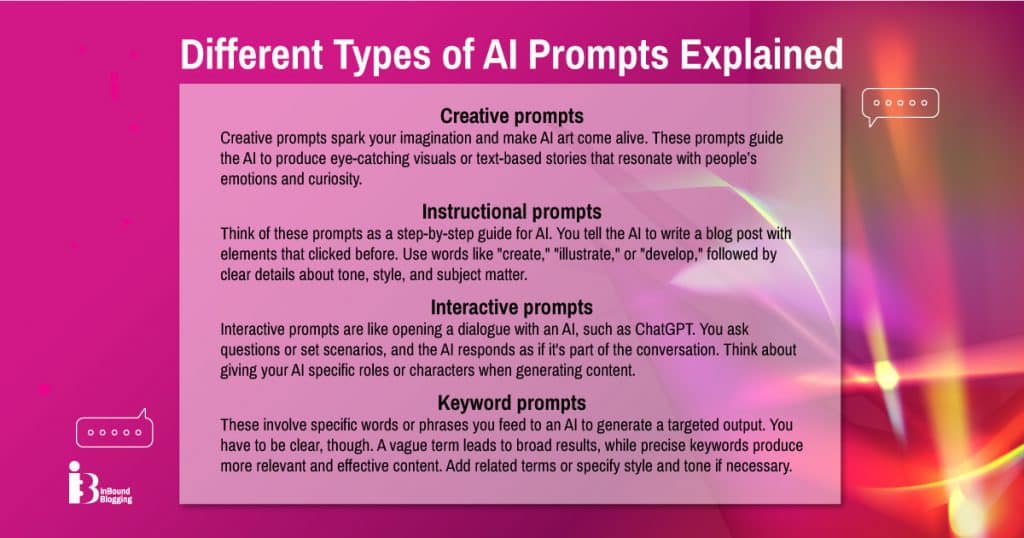
Diving into the world of AI prompts has the potential to unleash creativity. Whether you’re crafting tales, seeking precise guides, engaging in digital banter, or weaving keywords into gold, there’s a prompt out there waiting to transform your ideas into something extraordinary.
Let’s explore these varieties that can cater to every imaginative whim and practical need.
Creative prompts
Creative prompts spark your imagination and make AI art come alive. Picture this: you feed the AI a prompt like, “Create an oil painting of a cozy bookstore with hidden doorways.” The AI dives into action, merging ideas of warmth, mystery, and literature into one stunning visual piece. With lush details and vibrant colors, the generated image could tell a story all on its own.
Let’s explore another angle—social media posts crafted by smart prompts. You might type in something like “Write a social media post about an urban garden party under twinkling lights.” Suddenly, you have engaging content that paints vivid scenes for your followers.
These prompts guide the AI to produce eye-catching visuals or text-based stories that resonate with people’s emotions and curiosity. Use them wisely to achieve better results every time.
According to Dmitriy Bobriakov, Marketing Manager at RealEstateU, balanced prompts are the best:
“A prompt like ‘Write a short children’s story about a mouse who learns to fly’ gives clear guidance on the topic and genre but doesn’t prescribe every single detail. This allows the AI to come up with its own unique take within those parameters. An overly restrictive prompt would leave little room for creativity, while an overly vague one risks confusion or irrelevant results.”
Here’s what ChatGPT generated, based on Dmitriy’s prompt:
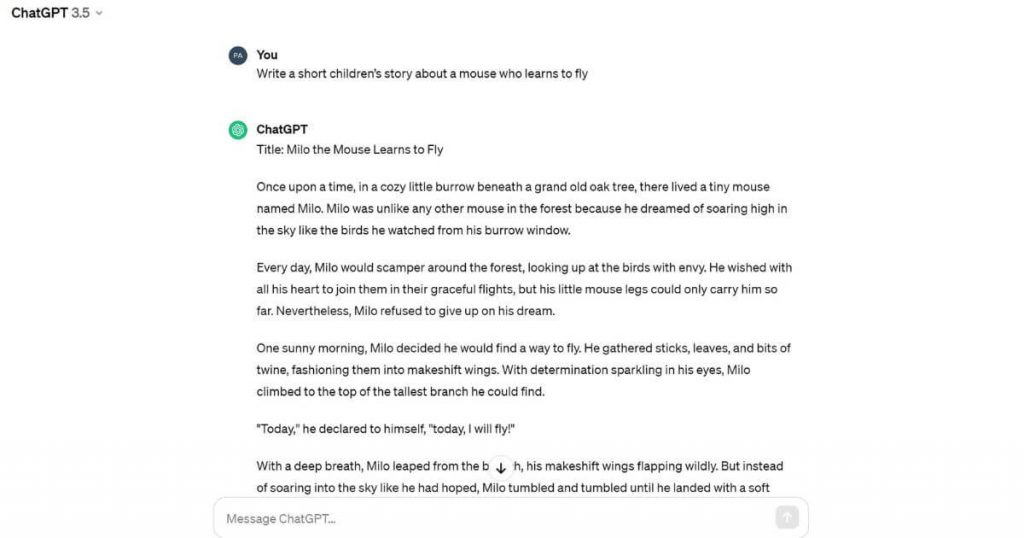
Actually, the story is quite engaging, and the ending has a profound lesson for children to learn. Try it as a bedtime story and see what your ending will be.
Instructional prompts
Moving on from the world of creative prompts, let’s dive into instructional prompts. These are your bread and butter for teaching AI exactly what you want. Think of these prompts as a step-by-step guide for AI. You’re in charge, giving specific commands to generate an output that matches your vision.
You tell the AI to write a blog post with elements that clicked before. Use words like “create,” “illustrate,” or “develop,” followed by clear details about tone, style, and subject matter. For example, if I’m aiming for stellar social media engagement, I’ll give detailed instructions on incorporating essential tools or sharing productivity hacks through my content creation tasks.
Keep refining it until it feels just right. Perfection might take multiple attempts, but getting there is all part of the experience.
“I’ve found that prompts asking AI to create detailed, structured content, like a podcast script, are particularly successful. For example, crafting a 10-minute podcast script discussing the role of software reviews in influencing business decisions has proven to be a favorite.” — Phil Strazzulla, Founder, Select Software Reviews
Interactive prompts
Interactive prompts are like opening a dialogue with an AI, such as ChatGPT. You ask questions or set scenarios, and the AI responds as if it’s part of the conversation. This is where creativity meets technology head-on.
For instance, you can ask AI to act as a customer service representative for your new product launch on social media. It’s not only practical but also gets you quick, relevant content tailored to your needs.
Let me tell you that harnessing interactive prompts can be a game-changer in how you engage with audiences online. Think about giving your AI specific roles or characters when generating content. This adds personality and makes your posts stand out.
If you are brainstorming ideas for SEO-related articles, you can start your prompt with, say, “You are an SEO expert with eight years of experience.” This way, your results will be far from generic.
Here’s the output I got:
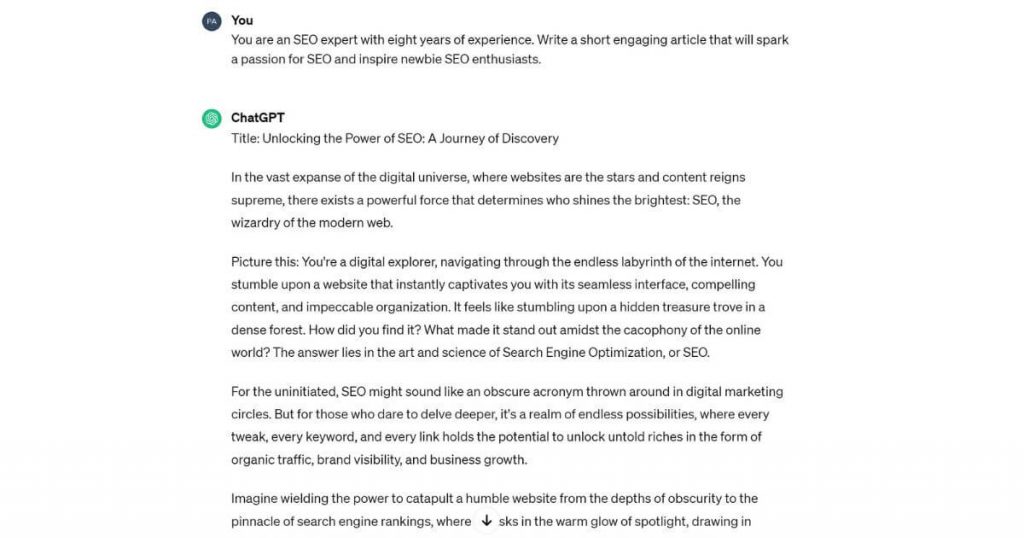
Play around by telling it to respond like an excited fan or a curious newcomer. It helps create truly unique and dynamic interactions that capture attention much more quickly.
Keyword prompts
Let’s now dive into keyword prompts. These involve specific words or phrases you feed to an AI to generate a targeted output. Think of them like secret codes that unlock the AI’s potential in narrow fields. Today, there is a wide variety of AI SEO tools that are useful to select your keywords beforehand.
Say you want to write about “natural beauty” for your brand. Using this in your keyword prompt guides the AI to generate content aligned with that theme.
Keywords act like a compass for AI, steering it toward the type of content you’re aiming for—whether it’s blog posts, art ideas, or social media updates. Mix and match keywords such as “stable diffusion,” “pop art,” or “eco-friendly tips” and watch how quickly the AI tailors its creations to fit those themes.
You have to be clear, though. A vague term leads to broad results, while precise keywords produce more relevant and effective content. Add related terms or specify style and tone if necessary, like asking for photorealistic images rather than just any picture style.
It’s all about guiding the tool to deliver exactly what you envision.
Here’s an example of a keyword prompt:
“I need to create a topical map focusing on the seed keyword “home fitness.” Please format a table with three columns (Main Topic, Category, Subcategory) to organize content clusters closely related to the seed keyword. Ensure that the keywords progress from broader to more specific topics, and avoid repetition of keywords within the table.”
And the answer’s below:
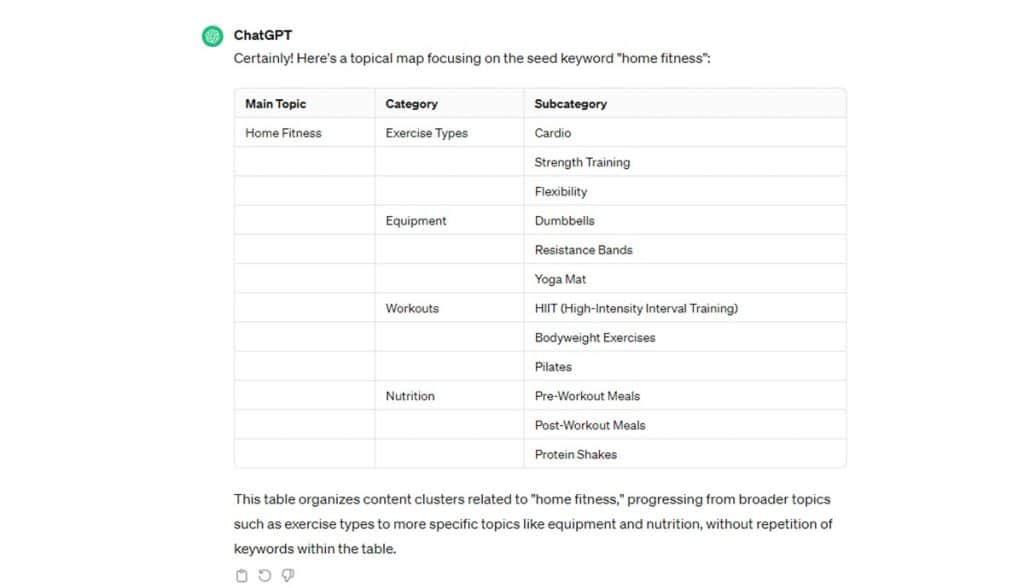
How to Write AI Prompts Effectively
You might be wondering how to get those high-quality, awe-inspiring outputs. That’s where mastering the craft comes in. It’s all about finesse; learning also delivers results that ignite your creativity.
Be specific
I love getting creative with AI. Being specific with prompts helps me craft amazing posts for social media.
- Keywords and/or hashtags are important. They help people find my social posts.
- My prompts always have a clear tone and style. For example, I might go for funny, serious, or friendly, or even ask the AI to mimic my own style as I first feed it a sample of my writing.
- It’s crucial to stick to branding guidelines. This keeps all my posts consistent and looks as though they belong together.
- Every prompt includes a call to action. Sometimes it’s a question or an invitation to share thoughts.
If possible, I will include relevant data to back up my prompt. And don’t forget the format of the output. Should it be a picture, a text post, or maybe even a video?
Consider tone and audience
Creating cool AI prompts is like crafting a message to a friend. You’ve got to hit the right tone and keep their interests in mind. If my language is off or I’m not thinking about who’s reading it, my message could fall flat.
- Tailor your language: Just like dressing for the occasion, pick words that match who you’re talking to. If I’m writing for an audience of AI enthusiasts, they’ll appreciate AI terms and insider jargon that can make them nod in agreement.
- Mind your tone: It’s all about striking that balance between casual and expert. Throw in some relaxed conversational phrases combined with solid knowledge.
- Reflect on response style: I consider how I want AI to respond, so I make sure I provide the AI with the whole story. Looking for quick tips or an in-depth guide? My phrasing leads the way, guiding AI to mirror my intent.
- Experiment thoughtfully: Sometimes, getting conversational tones right means trying different angles. Each attempt teaches me something new about how AI interprets human speech.
“I’ve found that including things like references, keywords, and tone helps minimize the potential for vagueness and taking the wrong route. This goes directly into how you should feel empowered to take control—AI works for you, not you for it. I’ll clarify with prompt points like ‘summarize’ or ‘provide as much detail as possible’ depending on how deep I want to dig for now.” — Stefan Campbell, Owner, The Small Business Blog
Build on previous prompts
To keep improving your interaction with AI, it’s crucial to build on what you have already achieved together. Here are some tips in this regard:
- Start by reading your five best-performing posts. See what made them work. Is it the humor, the insights, or the images you used? Use this style in your next post.
- Take note of common themes. Maybe you often talk about automation or share AI art prompt ideas. Mix these themes into new prompts for a touch of familiarity.
- Look at the audience’s reactions. Did they love a specific post? Try to figure out why and create a similar prompt.
- Check your last prompt’s outcomes. If it sparked lots of engagement, twist that same idea into something fresh.
- Keep evolving your language by using synonyms. For example, if “generate” was in your last successful prompt, switch it up with “create” in your next one to keep things interesting.
- Consider the format that works best. Is it questions, calls to action, or storytelling? Stick with what’s effective, but add a new spin to fresh content.
- Reflect on any feedback given by the AI tool. If it suggests making the prompts more concise, do that next time.
Dive into my article on human art vs AI art and witness how creativity and technology unfold before your eyes.
Correct mistakes and provide feedback
AI tools are powerful, but they need our guidance. Fixing errors and giving feedback makes the AI smarter and your content better. Here’s how to get it right:
- Specify your corrections. If the AI gets something wrong, tell it exactly what to fix. For instance, if an AI-generated post about dogs accidentally references cats, point out the mistake and ask for a revision focusing on dogs.
- Use positive reinforcement, too. When the AI nails it, let it know. Say things like “Great job with that playful tone,” or “You captured the main idea perfectly.”
- Be patient and persistent. You might not see perfect results immediately. AI learns over time, so keep correcting and providing detailed feedback.
- Track changes over time. Make a note of the progress the AI makes based on your inputs. Celebrating small improvements can encourage you to continue engaging with your chosen tool.
- Share AI prompt examples that have worked well. Doing so can help generate even better responses in future uses of prompts for AI.
“Don’t prompt AI to write like another specific person because that increases the chances of the AI plagiarizing content directly from that person. For example, it would be better to ask for a poem written in iambic pentameter with three quatrains and a couplet than to ask for a sonnet written as if it were by Shakespeare.” — Lauren Walter, Search and Content Director, Online Optimism
Real-Life AI Prompts Examples
Finally, take a look at some real-life examples of AI prompts and how they are used to generate content for different purposes:
- Create content to educate your audience
“Compose a 600-word op-ed in a persuasive tone discussing the role of annuities in retirement planning. The piece should include an introduction, a discussion of the benefits and risks of annuities, and a conclusion.” — Shawn Plummer, CEO, The Annuity Expert
He says that this is his favorite type of prompt because it perfectly encapsulates his company’s aim: to educate and guide the audience on the particular topic.
That’s ChatGPT’s answer to Shawn’s AI prompt:
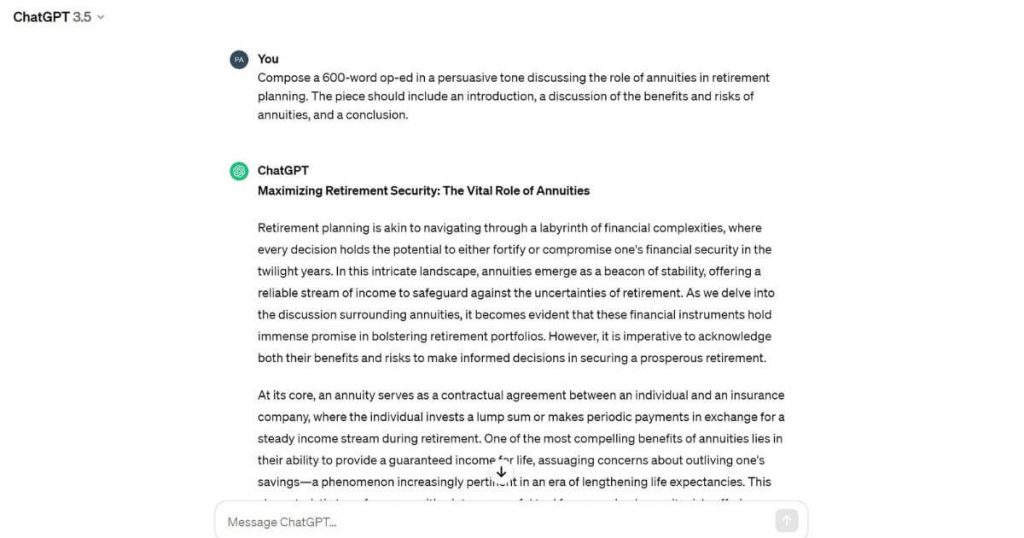
- Simplify complex ideas:
“Explain this concept to me like I’m a 5-year-old.” — Shawn Stack, Founder and CEO of Hallmark Timmins
In his opinion, this AI prompt stimulates the AI to come up with creative, bite-sized pieces that end users can easily understand.
“When I prompted an AI to explain machine learning like I was 5 years old, it came up with a baking analogy. It compared inputting data to a machine learning model to giving a recipe to a baker. The model then uses that recipe to ‘bake’ predictions and insights, just like a baker uses a recipe to bake cookies. This simple analogy helped me grasp the essence of ML much faster than a technical definition filled with jargon.” Stack adds.
- Use the “Purpose-Method-Result” technique
“As a [type of blog post], craft a personalized message that resonates with your [ideal customer persona] by focusing on their specific needs and desires and compelling them to take [desired action] with a clear value proposition.” — Amit Raj, Founder and CEO, The Links Guy
“When crafting content, prompts written naturally in normal language and that provide unambiguous guidelines tend to produce higher-quality output. Using standard formulas like Purpose-Method-Result and including examples can further boost how effective prompts are.” Amit shares.
Conclusion
Now you’ve got the scoop on AI prompts. Are you ready to give them a whirl? Dive in, mix it up, and watch your creativity soar. Remember, the more specific you are with your prompts, the sharper the AI’s output.
And hey, don’t forget to have fun along the way. After all, that’s what sparking new ideas is all about.
FAQ
How do I write good AI prompts?
Start by being clear and specific about what you want the AI to create. Use descriptive words and include any important details, such as style, aspect ratio for images, or tone for text.
Why am I not getting great results from my AI-generated art?
It’s common to face challenges when starting with AI art generators. To improve your results, try adding more details and experimenting with different keywords.
Can I learn how to use prompts with an image generator?
Absolutely. If you’re interested in creating AI images, just enter a detailed prompt into the image generator tool and let the software do its magic.
Are there ready-made AI prompts I can use for practice?
Yes. There are many ready-made prompt examples online that can guide you on how to write effective ones of your own.
What should I do if my first prompt doesn’t work well with the AI model?
If your first attempt didn’t generate what you expected, try tweaking and adding more context to your prompt. It’s normal to ideate several times before hitting the mark.
Are there any prompts AI can’t answer?
Yes, AI tools and chatbots typically refuse to provide medical, legal, or financial advice as well as engage in discussions related to violence, hate speech, and certain politically sensitive subjects. Additionally, AI may struggle with prompts that require complex emotional understanding.



